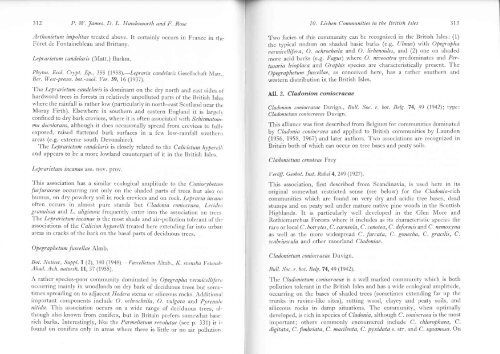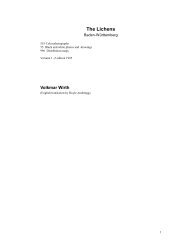Lichen communities in the British Isles: A preliminary conspectus
Lichen communities in the British Isles: A preliminary conspectus
Lichen communities in the British Isles: A preliminary conspectus
Create successful ePaper yourself
Turn your PDF publications into a flip-book with our unique Google optimized e-Paper software.
312 P. W. James, D. L. Hawksztorth and F. Rose<br />
Artlrcnietum impolitae treated above. It certa<strong>in</strong>ly occurs <strong>in</strong> Francc <strong>in</strong> tirc<br />
F6rct de Fonta<strong>in</strong>ebleau and Brittany.<br />
Leprarietum candelaris (Matt.) Barkm.<br />
Phytos. Ecol. crypt. Ep., 355 (1958).-Lestraria candelarr-s Gesellschaft N,Iatt..<br />
Ber. West-preuss" bot.-zool. Ver. 59, 16 (1937)"<br />
'lhe Leprarietum candelarzl is dom<strong>in</strong>ant on <strong>the</strong> dry north and east sicles o1,<br />
hardwood trees <strong>in</strong> forests <strong>in</strong> relatively unpolluted parts of <strong>the</strong> <strong>British</strong> Islcs<br />
where <strong>the</strong> ra<strong>in</strong>fall is ra<strong>the</strong>r low (particularly <strong>in</strong> north-east scotland near <strong>the</strong><br />
Moray Firth). Elsewhere <strong>in</strong> sou<strong>the</strong>rn and eastern England it is largeh,<br />
conf<strong>in</strong>ed to dry bark crevices, where it is often associated with Schismatonrma<br />
decolorans, although it does occasronally sprcad from crevices to fulh'<br />
exposed, raised flattened bark surfaces <strong>in</strong> a few lotv-ra<strong>in</strong>fall southcrn<br />
areas (e.g. extreme south Devonshire).<br />
The Leprarietum candelarzs is closely related to <strong>the</strong> calicietum hy'perel.li<br />
and appears to be a more lowland countcrpart of it <strong>in</strong> <strong>the</strong> <strong>British</strong> <strong>Isles</strong>.<br />
Leprarietum '<strong>in</strong>canae ass. nov" prov.<br />
l'his association has a similar ecological amplitude to <strong>the</strong> coniocybetunr<br />
.furfuraceae occurr<strong>in</strong>g not only on <strong>the</strong> shadecl parts of trees but also o'<br />
humrrs, on dry porvdery soil <strong>in</strong> rock crer.ices and on rock. Lepraria <strong>in</strong>canu<br />
often occurs <strong>in</strong> almost purc stands l>ut cladonia coniocraea, Lecideu<br />
granulosa and L. ulig<strong>in</strong>osa frcquently cnter <strong>in</strong>to <strong>the</strong> association on trees.<br />
a'he Leprarietum <strong>in</strong>canae is <strong>the</strong> most shade and air-pollution tolerant of tht<br />
associations of <strong>the</strong> Calicion hyperelli treated here extend<strong>in</strong>g far <strong>in</strong>to urban<br />
areas <strong>in</strong> cracks of <strong>the</strong> bark on <strong>the</strong> basal parts of deciduous trecs.<br />
O p egr aphe tum fus c e ll ae Almb.<br />
Bot. Notiser, Suppl. I (2), 140 (1948). F'uscelletmn Almb., K. sxenska Vetensh-<br />
Akad. At:h. natursk.lf , 37 (1955).<br />
A ra<strong>the</strong>r specics-poor community dom<strong>in</strong>ated by opegrapha xernicelliJert,<br />
occurr<strong>in</strong>g ma<strong>in</strong>ly <strong>in</strong> woodlands on dry bark of deciduous trees but somctimes<br />
spread<strong>in</strong>g on to adjacent Hedera stems or siliceous rocks. Aclditional<br />
important components <strong>in</strong>clude O. ochrctcheila, O. z;ulgata and Pyrenulu<br />
nitida. This association occurs on a wide range of deciduous trees, al,<br />
though also knorn'n from conifers, but <strong>in</strong> Brita<strong>in</strong> prefers somewhat bascrich<br />
barks. Interest<strong>in</strong>gly, like <strong>the</strong> Parmelietum reL^olutae (see p. 331) it is<br />
found on conifers only <strong>in</strong> areas where <strong>the</strong>re is little or no air pollution<br />
10. <strong>Lichen</strong> Communities <strong>in</strong> <strong>the</strong> <strong>British</strong> <strong>Isles</strong> 313<br />
Two facies of this community can bc recognized <strong>in</strong> <strong>the</strong> <strong>British</strong> <strong>Isles</strong>: (1)<br />
<strong>the</strong> typical nodum on shaded basic barks (.e.g. Lllmus) with Opegrapha<br />
t:ernricellifera, O. ochrocheila and O. lichenoides, and (2) onc on shaded<br />
more acid barks (e.g. Fagus) where O. niveoatra predom<strong>in</strong>ates and Pertusaria<br />
leioplaca and Graphis species are characteristically present. The<br />
Opegraphetum fuscellae, as conceived here, has a ra<strong>the</strong>r sou<strong>the</strong>rn and<br />
western distribution <strong>in</strong> <strong>the</strong> <strong>British</strong> <strong>Isles</strong>.<br />
Lll. 2. Clq.donion coniocraeae<br />
Cladonion coniocraeae Dr,rvign., Bull. Soc. r. bot. Belg. 74, +9 (1942); type:<br />
C ladonietum conio cr ae ae Duvign.<br />
This alliance was first describcd from Belgium for <strong>communities</strong> dom<strong>in</strong>ated<br />
by Cladonia coniocraea and applicd to <strong>British</strong> <strong>communities</strong> by Laundon<br />
(1956, 1958, 1967) and later authors. 'l'wo associations are recognized <strong>in</strong><br />
Brita<strong>in</strong> both of r,vhich can occur on tree bases ancl peaty soils.<br />
C ladonietum c enote ae F r ey<br />
Verdff . Geobot. Inst. Rubel 4,2+9 (1927).<br />
This association, first described from Scand<strong>in</strong>avia, is used here <strong>in</strong> its<br />
orig<strong>in</strong>al somewhat restricted sense (see below) for <strong>the</strong> Cladonia-rich<br />
<strong>communities</strong> which are found on very dry and acidic tree bases, dead<br />
stumps and on peaty soil under mature native p<strong>in</strong>e woods <strong>in</strong> <strong>the</strong> Scottish<br />
I{ighlands. It is particularly well developed <strong>in</strong> <strong>the</strong> Glen More and<br />
Rothiemurchus Forests where it <strong>in</strong>cludes as its characteristic species <strong>the</strong><br />
rare or local C. botrytes, C. carneola, C. cenotea, C. defctrniis and C. nemoxyna<br />
as well as <strong>the</strong> more widespread C. furcata, C. gonecha, C" gracilis, C.<br />
scabriuscula and o<strong>the</strong>r moorland Cladoniae.<br />
C ladonietum c oniocr ae ae D uvign.<br />
Bull. Soc. r. bot. Belg.74, +9 (19+2).<br />
\-he Cladonietum coniocraeae is a well marked community which is both<br />
pollution tolerant <strong>in</strong> <strong>the</strong> <strong>British</strong> <strong>Isles</strong> and has a wide ecological amplitude,<br />
occurr<strong>in</strong>g on <strong>the</strong> bases of shaded trees (sometimes extend<strong>in</strong>g far up <strong>the</strong><br />
trunks <strong>in</strong> rav<strong>in</strong>e-like sites), rott<strong>in</strong>g wood, clayey and pcaty soils, and<br />
siliceous rocks <strong>in</strong> damp situations. The community, when optimally<br />
developed, is rich <strong>in</strong> species of Cladonia, although C. coniocraea is <strong>the</strong> most<br />
important; o<strong>the</strong>rs commonly encountered <strong>in</strong>clude C. chlorophaea, C'<br />
digitata, C. fmbriata, C. macilen.ta, C.'pyxidata. s. str. and C. squamosa" An





